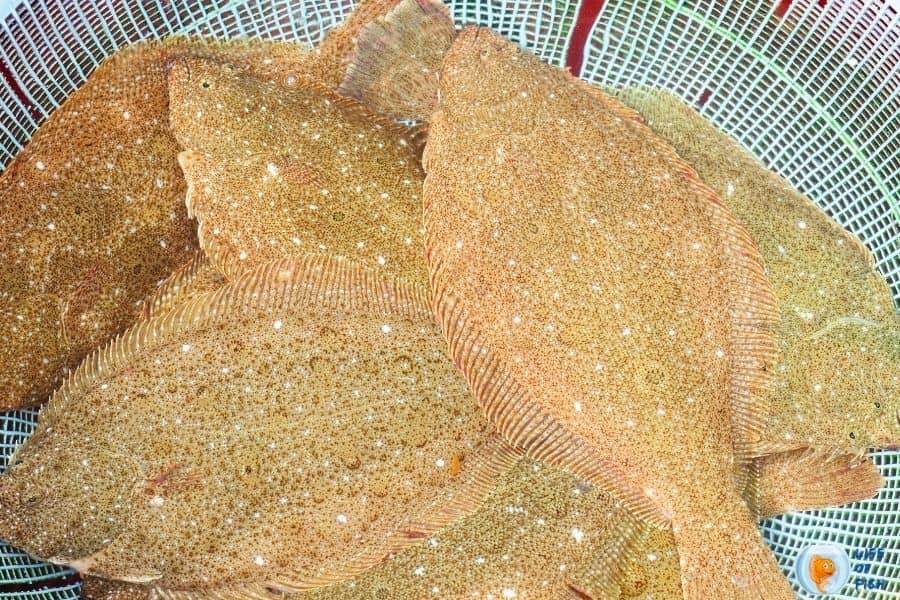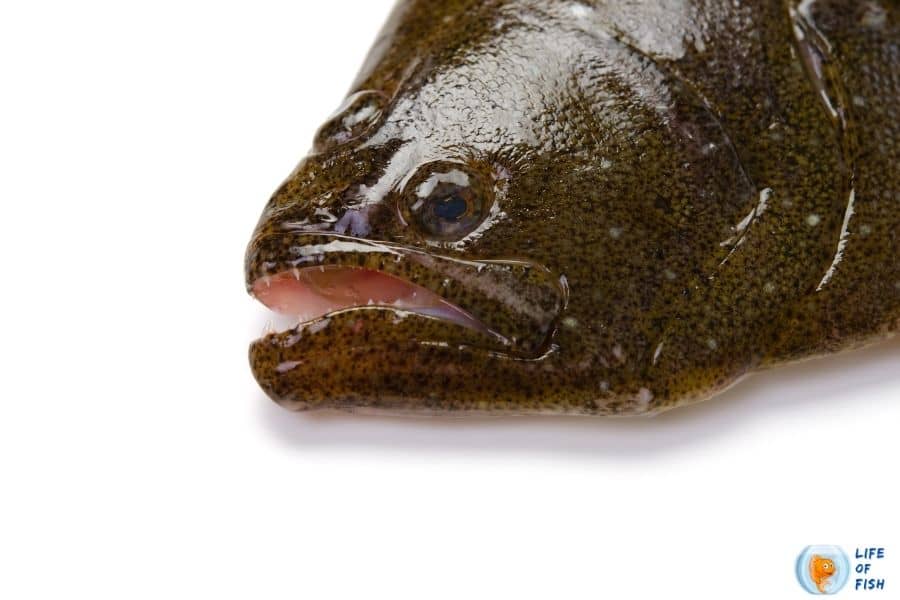Olive Flounder, also known as bastard halibut, Japanese halibut, Hirame, False Halibut, Cardeau hirame, Zomervogel, Japanese flatfish, or Korean flatfish, is the highest valued finfish in the world.
It is popular in Korea because of its good taste and dress-out yield. The market demand for this fish is high.
In 2017, the production of Olive Flounder was 43000 tons, while all other fisheries were only 10000 tons.
Although it has a higher demand, aquaculture production has not been increased by more than 50000 metric tons per year. Therefore, it is overpriced. Large olive flounder fish sell for 800 Bells in Korea.

What is Olive flounder
Jump To
Scientifically named Paralichthys olivaceus, Olive Flounder is temperate marine species of large-tooth Flounder (Paralichthyidae).
They are native to the North-western Pacific Ocean. Often found in Japan, Sakhalin, Kuril Islands, Korean Peninsula, to the South China Sea.
These fish are also called Japanese flatfish or Korea(n) flatfish (광어). This fish has a rapid growth rate hence is considered excellent for aquaculture.
It is the top producing aquaculture finfish in Korea, producing around 50,000 metric tons of Flounder per year.
How Olive Flounder looks like
Olive Flounder is a flatfish species that can be found in soft and muddy offshore, coastal areas down to 100 meters in depth.
Color
Olive flounders are brown in color. The color is lighter than the dab fish, but they are left-eyed (unlike dab).
Shape
Olive Flounder is a flatfish that is bent on one side and swims like they float. The right eye of the fish is maneuvered toward the left, and the body is sort of diamond-shaped. Olive Flounder doesn’t have any spines.
Instead, it has 77 to 81 dorsal soft rays and 59 to 61 anal soft rays. It also has 38 vertebrae that help it to swim. Olive flounders swim with the help of their body and the caudal fin.
Size
Olive flounders grow for about 103 cm (41 in) in length and 9.1 kg (20 lb) in weight.
Growth rate of Olive Flounder
Olive flounder larvae are just like any other fish. They have eyes on both sides and swim like any other fish.
When they grow to about 1 mm in length after 25 to 60 days, they take a new unusual turn. They rotate their body to the other side.
When they turn to the side, their right eye maneuvers towards the left. The right side of the fish then becomes their belly or their backside, and the left side becomes the upside. This process is called the “metamorphosis.”

Male and female fish
According to the National Library of Medicine1, olive flounder female fish grow faster than male fish before the size grading occurs.
A mature female fish at the age of 3 is 40cm long while the male is only 30cm long.
Where Olive flounder live
Olive flounders’ habitats are in soft and muddy offshores and the coastal regions where the water level goes down to 100 meters in depth.
They are often found in Japanese waters in the North-western Pacific Ocean. Because of this, they’re also known as Japanese flatfish.
Olive flounders are temperate marine species that prefer hot weather conditions. They prefer a temperature between 21- 24 °C or 69 -75 °F. You may also find them in Mariana’s Trench.
Olive flounders travel to the shallow waters for reproduction anytime from January through August, about 70 cm in depth.
The eggs and larvae remain in these shallow waters for about 25 to 50 days. Then, they start to move onto the sandy areas during the metamorphosis process.
In sandy areas, these fish feed on shrimps, and once they achieve metamorphosis, they move offshore.
What they eat
Olive flounders usually feed on nekton, spawn, crustaceans, polychaetes, and small fish in the wild. In aquaculture farms, farmers feed them with commercial feeds, farm-made fish pellets, and raw fish.
Olive flounder reproduction
Olive flounders sexually mature in 3 years when female fish reach 40cm and male fish reach 30cm. They start to spawn after they are sexually mature.
Olive flounder reproduction occurs anytime between January to August in shallow waters. They are egg scatterers that do external fertilization.
It means that male fish fertilize the eggs while female fish lays eggs in the open waters. Olive flounders do not guard their eggs or fry. Once they finish laying eggs, they move offshore.
The eggs and larvae remain in these shallow waters for about 25 to 50 days. Then, they start to move onto the sandy areas during the metamorphosis process.
In sandy areas, these fish feed on shrimps, and once they achieve metamorphosis, they move offshore.
Importance of Olive Flounder
Olive Flounder is an important commercial fish. It is the most produced culture fish in Korea, and it sells for a higher price.
Ecosystem balance
Olive flounders are secondary predators in the food chain. They feed on nekton, spawn, crustaceans, polychaetes, and small fish. Predators like bony fish, sharks, and rays prey on olive flounders in the wild.
Sportfishing
Olive Flounder is not a game fish. This fish is a highly commercial fish that has a higher demand in the fish food market.
As a food
Olive Flounder is the Most highly prized of the Japanese flounders because of its good taste and dress-out yield.
This fish is so prevalent in Korea that olive flounders’ aquaculture production alone reaches 50,000 metric tons per year. It is served in a variety of forms, the most common of which being hoe.
Aquaculture
Olive Flounder is an important aquaculture species because of its high growth rate, tolerance to water temperature changes, feed efficiency, and resistance to diseases.
It is the top-produced cultured finfish in Korea for more than ten years.
In 2017, aquaculture Olive flounder production reached 43 thousand metric tons while all other fish were only 10 thousand metric tons.
The Republic of Korea produces more than 70 percent of the global supply of Olive flounders, while Japan being the second, followed by Argentina and Uruguay.
The aquaculture of this fish started in the late 1980s, and since then, it has exploded. In 2005, the aquaculture production of live flounders reached 40 thousand metric tons while wild captured Olive flounder amount was only 2112 metric tons.

Related question
What kind of fish is an olive flounder?
Olive Flounder is a flatfish of the family Paralichthyidae (large-tooth flounders). It is a ray-finned fish found in the North-western Pacific Ocean.
It lives in the temperate marine waters in soft and muddy offshores and the coastal regions near Japanese waters at the depths of 100m.
What does Olive Flounder taste like?
Olive Flounder has a subtle, sweet taste, but it is more appreciated for its texture. The taste of Olive Flounder is often similar to fish like branzino, halibut, and tilapia.
This fish is extremely popular in Korea. The Koreans prepare several types of meals with Olive Flounders. The most common dish is the hoe.
Olive flounders are famous not only for their taste but also for their nutritional benefits. It is rich in Calcium, Irion, Protein, Omega3, Selenium, Vitamin A, and Zinc.
Are Olive flounders poisonous?
No. Olive flounders are not poisonous to humans.
They are very nutritious and delicious food to humans. However, if the fish is infected by a microscopic parasite called Kudoa septempunctata, consuming raw fish can cause food poisoning.
This parasite causes transient diarrhea and vomiting for several hours after eating. This infection is called Kudoa food poisoning.
However, the symptoms are not severe, and the recovery is rapid. Kudoa food poisoning often occurs from August to October.
From November to May, only a few cases are reported. If you consume this fish cooked, you can avoid this problem.
Are Olive flounders good to eat?
Yes. Olive flounders are very nutritious food you can consume. According to Fishbase, the nutrition values of 100g of Olive Flounder are as follows,
Iron = 0.958 [0.565 to 1.602] mg
Calcium = 49.1 [23.9 to 109.4] mg
Zinc = 0.485 [0.323 to 0.701] mg (wet weight)
Selenium = 42.6 [20.7 to 82.2] μg
Protein = 17.3 [14.8 to 20.3] %
VitaminA = 16.6 [4.9 to 53.5] μg
Omega3 = 0.284 [0.146 to 0.510] g
As you see, Olive flounders are Calcium, Protein, and Iron-rich fish that have a very delicious taste.
These fish are very popular among Koreans because of their excellent taste and dress-out yield. They serve Olive flounders in several ways, and “Hoe” is Koreans’ most popular Olive flounder dish.

Conclusion
Olive Flounder is a flatfish species that is very popular in commercial aquaculture. Olive Flounder is the highest valued finfish in the world.
It is popular in Korea because of its good taste and dress-out yield. Olive flounders have a subtle, sweet taste but most people appreciate them for their texture.
The yearly aquaculture production of Olive flounders reaches 50,000 metric tons because of its high demand.
Although the production is high, this fish is highly priced in the market. You can buy large olive flounders for 800 Bells in Korea.
Reference
- Fan Z, You F, Wang L, Weng S, Wu Z, Hu J, Zou Y, Tan X, Zhang P. Gonadal transcriptome analysis of male and female olive flounder (Paralichthys olivaceus). Biomed Res Int. 2014;2014:291067. doi: 10.1155/2014/291067. Epub 2014 Jul 6. PMID: 25121093; PMCID: PMC4121151.
- Froese, R. and D. Pauly. Editors. 2021.FishBase
Read Next: Female Honey Gourami | 9 Fascinating Facts You Must Know |
